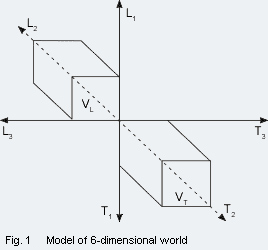Glamour and Emptiness of our worldProbably everyone is Russia knows «The Master and Margaret», a novel by M.Bulgakov. But just a few might know that prototype of well-known Woland was Roberto Bartini, whom the author knew and whose works admired. As you remember the Ball of Woland took place in 5-room apartment. When Koroviev led Margaret to the Ball, she said: «... mostly I am surprised, where all this is situated, — she moved the hand, stressing the immensity of the hall. Koroviev sweetly smiled, shadows moving in his nose wrinkles. — The simplest of all! — He answered. — For those who are well acquainted with 5th dimension, is nothing easier than expand the apartment towards desired limits. Even should I say, dear mistress, to devil knows which limits!» Robert Bartini (Roberto Oros di Bartini, 1897 — 1974), Italian aristocrat, baron, communist. Left fascist Italy and came to the USSR. Famous aircraft designer, theoretical physicist, cosmogonist and philosopher. In the Soviet Union he was classified due to his extraordinary mind. Sergey Pavlovich Korolev called Bartini as his teacher. Bartini was secret inspirator of the soviet cosmic program. 
To make the calculations formulas of flying machines easier, Bartini developed the theory of 6-dimensional world, which was later called «Bartini’s world». Above ordinary Cartezian coordinate system of 3-dimensional space, Bartini suggested to consider the same 3-dimensional model of time with 3 orthogonal axes. Schematically this model is at Fig. 1 (from Wikipedia). «Past, present and future are the same, — said Bartini. — Time is like a road: it does not disappear after we have walked it and does not emerge every second, revealed after the road turn.» Similar view on the world was shared by N.A.Kozyrev: «Time does not spread like light waves, but appears at once in the whole Universe, and binds the objects of our environment.» Investigation of (3+3)-dimensional space-time allowed Bartini to come to the following conclusion in 1965: «physics equations take easier form, when kinematic system (LT) is taken as dimensional system», which allows to imagine each physical value as «uniform» analytical equation [1, p. 861, 864]. Year later another work issued [2]. In this work all dimensionalities of physical units are expressed via 2 parameters only: L — space and T — time. Just to note that nowadays The International System of Units (SI) is using 7 main units (length, mass, time, the amount of substance, temperature, electric current, luminous intensity), 2 additional units (straight angle and solid angle) and about 200 derivates. Such presentation of all physical dimensions just in 2 parameters allowed him to see all laws of physics in the table, similar to Mendeleev’s table. Based on this table he predicted and then discovered the new conservation law — conservation of mobility. Table consists of infinite vertical columns, which represent the row of integral orders of length, and infinite horizontal lines, which represent integral orders of time (at our picture their number is limited). Cross of the column and the line represents dimension of particular physical parameter.
As you can see from the table, many physical parameters have the same dimension; and many cells are not filled, which shows our inability to operate with them. Let us look at such fundamental parameter as mass. In XIX century Maxwell, based on empirically discovered 3rd Kepler’s law, stated that correlation of the cube of the orbital period of the planet (for the orbit of the planet circling around the Sun) to the square of its orbital period is the constant, L3·T-2. This constant is the same for all planet movements, and is called — mass. No less fundamental is Bartini’s conclusion that electric charge in this system has the same dimension [2, p. 255]. Based on this table and its analysis, we can make the conclusion: all substance consists of isotropic space-time. Figuratively speaking, whirling and condensing, increasing thus its dimensionality, all physical objects in the Universe are created. And it also means that any object consists (and is the continuation) of all other objects. Thus, dear reader of this text, you and me consist of one and the same space-time and are prolongations of each other, and in the essence we are absolutely empty, empty as the space, in which we are. Everything that we percept as densities, is just the same space-time, only condensed space-time. And there is nothing else. It is interesting to notice that people had this knowledge since a long time. The ancient knowledge, Dzogchen, states that all world phenomena are empty. Later this knowledge was used by Buddhists. Deep understanding of it allows those who practice Dzogchen to do what modern science is not able to explain. Reaching complete realization, masters do not die as people die; they dissolve their body in the rainbow light, transforming it to non-material state. So the world is not what it seems. Accurate reader would like to know, what about relativistic physics and quant mechanics? From the point of view of group theory, Einstein relativistic dynamics is just deformation of Newton classical mechanics. Quant mechanics is also deformation of classical mechanics. And there will be no further conceptual deformation for special relativistic theory and quant mechanics — they form stable group [4]. While classical mechanics is, in general, infinite system for new deformations, and has reserves for description of all new structures, connected with space-time. Thus it does not matter, which geometry we take for description of physical objects — Euclid, Lobachevski or any other. Any multitude of geometries, each being group of movements, will have different invariants. Kinematic system of physical values, suggested by R.O. di Bartini, gives system of invariants for infinite variety of groups of movements, so for infinite multitude of geometries. Each of these geometries corresponds to certain natural phenomena, so speaking, to certain «special» physics. The complete system of invariants embraces all known and yet unknown classes of natural phenomena [5]. To continue in «About the Time» Now you can also find physical worldview just from another point in the article
Keep reference to the original resource https://noocosmology.com/article/glamour_and_emptiness_of_our_world.html |

Man on the way towards «Cosmic Consciousness» Structure of spiritual Hierarchy in Metasocmos Spirits, soul and consciousness What physicists observed behind the exotic phenomenon Glamour and Emptiness of our world About soul organization, choice and spiritual development Some problems of modern science Antimatter and perfecting of the soul Higgs boson and questions of modern physics Security in the modern world: problems and tasks What is hidden under the cover of apparentness in mathematics and in the usual world around us How modern people understand the world, roots of this understanding and related problems of life 

|
||||||||||||||||||||||||||||||||||||||||||||||||||||||||
|
All rights reserved and are protected by law © 2012 Internet portal «Noocosmology»
For using these materials, hyperlink is obligatory.
|






